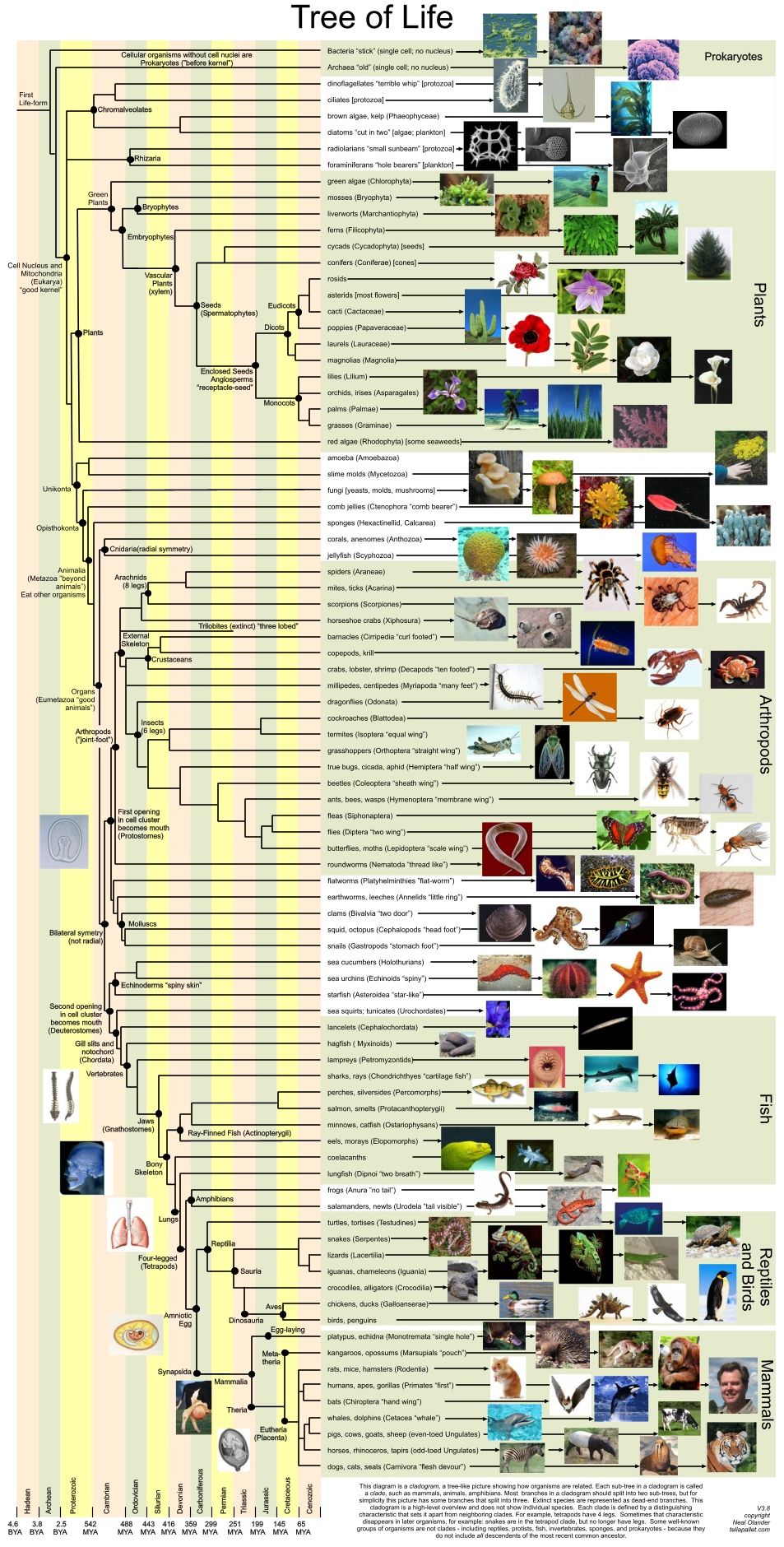
Tree of Life diagram by Neal Olander, integrating cladistics (here, vertical axis) with deep time (horizontal axis). Creative Commons Attribution-Noncommercial-Share Alike 3.0 United States License.
| The Phylogenetic Tree | ||
| Systematics | The Phylogenetic Tree |
| Linnaean taxonomy | Early evolutionary trees | |
| Linnaean taxonomy | Evolutionary systematics |
Phylogeny and Systematics |
The Phylogenetic Tree Early trees Darwin's tree Haeckel's trees |
 Tree of Life diagram by Neal Olander, integrating cladistics (here, vertical axis) with deep time (horizontal axis). Creative Commons Attribution-Noncommercial-Share Alike 3.0 United States License. |
The central principle of understanding the evolutionary of life on Earth is the Phylogenetic Tree, sometimes called the "Tree of Life" (not to be confused with the biblical tree of the same name). That is, evolution does not proceed in a simple straight line, but takes the form of a vast tree-like path consisting of various diverging, and sometimes also converging, branches going in many different directions.
This insight, that evolution is tree-like, constituted a huge shift in understanding that still has not totally overthrown the old linear thinking in much of popular culture (consider for example the influence of the iconic and the much misunderstood March of Progress with its simplistic linear model of human evolution).
Like the geological timescale, the periodic table of elements, of diagrams of the big bang, the evolutionary tree of life is one of those iconic grand vista theory of everything images that are visually associated with science at its most sweeping, in this case with biology and evolution. Hence we felt some space should be devoted to it, even if this section is still a bit scanty. The image featured above presents a modern version of the phylogenetic tree, but it was preceeded my many earlier versions and paradigms, and no dopubt will be succeeded by many future ones
This unit begins with the earliest attempts at evolutionary trees the beginning of the 19th century, and continues through to the grand illustrations of Haeckel, which shaped and still shape our understanding of what an evolutionary tree looks like. After Haeckel came evolutionary systematics and spindle diagrams, and after them cladograms and dendrograms, like the image at the top of the page, which represent the current version of the tree of life. Note that cladograms are not evolutionary trees meant to trace the actual course of evolution, they are phylogenetic hypotheses representing a best guess approach of the branching pattern of that evolutionary tree. Most popular enthusiasts however like to be more concrete, so we pretend (at least until better evidence comes along) that one of these cladograms is an actual phylogeny. Like spindle diagrams and like the image on this page, the dendrograms that feature in Palaeos are modified versions of cladograms which emphasise a purported phylogeny rather than a hypothesis. MAK130328
Links: The Great Tree of Life diagram, artistic semi-stylised but still useful representation, by Leonard Eisenberg, evogeneao (evolutionary genealogy) website; The Tree of Life: Tangled Roots and Sexy Shoots — Tracing the genetic pathway from the first Eukaryotes to Homo sapiens by Chris King (Biocosmology and Consciousness Research), huge "big picture" coverage; Wikipedia Tree of Life a valuable reference website (albeit still very incomplete, although some taxa, e.g. Agnatha, Ankylosauria, are well represented) with the an interactive presentation of the full "tree of life". Detailed references are supplied on each page about particular organisms. It is not entirely up to date with latest ideas; for example, the tree of Eutheria fails to reflect the recent classification into Laurasiatheria, Afrotheria, Euarchontoglires, and Xenarthra. Link (EvoWiki). MAK111018;
| Linnaean taxonomy | Early evolutionary trees |
content by MAK130328